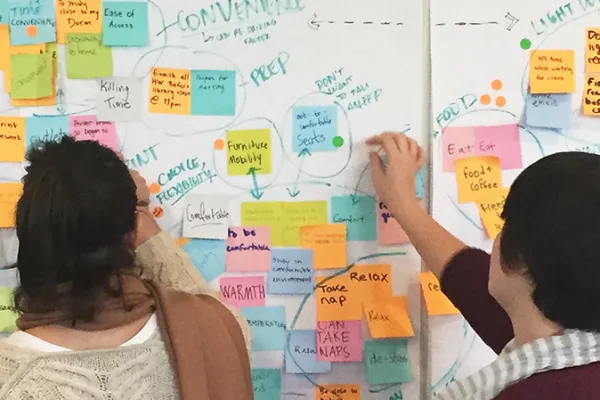Program Phase of Library Redesign Draws Participation Across Campus

Published December 14, 2015
Close to 1,900 students, faculty, staff and alumnae have participated in the initial phase of reimagining Neilson Library.
Shepley Bulfinch, the national design firm that is partnering with acclaimed designer Maya Lin on the library redesign, reports that about 1,864 members of the college community have taken part in “engagement sessions” this semester—including nearly 200 at an alumnae event on campus.
The more than 30 sessions held this fall have been varied, including open-themed discussions, library and house teas, faculty lunches, one-on-one interviews with faculty and students and an online survey. Sessions have been led by Shepley Bulfinch, the Student Advisory Committee and Brightspot, an anthropological consultant to the library project.
Provost Katherine Rowe, chair of the Library Program Committee, said the diversity of entry points is designed “to help reach all parts of the Smith community in as many ways as possible for ideas about what needs to be included in a reimagined Neilson.”
The program committee, which includes students, faculty, staff and trustees, is also hosting “playback sessions” to share emerging themes about the library redesign. The next one, a digital poster session with committee members, Shepley Bulfinch and Brightspot consultants, will be held Wednesday, Dec. 16, from noon to 2:30 p.m. and 5:30 to 7:30 p.m. in Neilson Browsing Room.
The library redesign, which began in 2010, is the college’s largest capital project of the decade and the first renovation of Neilson since 1982. The programming phase—aimed at creating a guiding framework for what will be housed in a future Neilson—begins to wrap up in January 2016, when a draft program with recommendations will be presented to the faculty and trustees for final feedback. That program will include a vision and framework for the library renovation, including recommendations on services, collections and units that will be part of the new complex of Neilson and the Alumnae Gym.
Next semester, the project moves into a new stage led by the Library Design Committee chaired by President Kathleen McCartney. The design phase will feature the first visual plans for a reimagined Neilson, with opportunities for feedback from the campus community. Construction is expected to begin in 2017.
Carole Wedge, president of Shepley Bulfinch, said the programming phase has been marked by “incredibly thoughtful” participation by all segments of the college community.
“The process is helping to create an authentic Smith sense of what the reimagined library needs to be,” Wedge said. “We’ve had lots of input, and we want to be loyal to that input going forward.”
Engagement sessions have centered on key themes related to the library redesign, including types of space, flexibility of space, technology and the future of Smith’s unique collections and archives. Other important issues discussed during the sessions have included the sustainability, diversity and accessibility goals of the complex, as well as its resources and services.
At a lunchtime discussion on sustainability, for example, dozens of faculty, students and staff gathered in Neilson Browsing Room to share ideas for ways to reduce the environmental impact of a redesigned library building. Participants also brainstormed about how a sustainable library can be part of teaching, research and learning at Smith.
Sara DiNoto, an interior designer at Shepley Bulfinch, said part of what makes the Smith project unique is how deeply the college community cares about the future of Neilson.
“The level of engagement has been expansive,” said DiNoto, who noted that the online survey alone drew 956 responses. “There is real interest in having this broad conversation about the library.”
The upcoming design phase will appear “quieter,” DiNoto said, with fewer public discussion sessions. Maya Lin will use the framework developed during the current program phase as the basis for designing a new library.
Director of Libraries Christopher Loring said the planning process has created “a lot of hope” about reimagining Neilson.
Loring said the emerging vision for a renovated library highlights the importance of special collections, digital and print scholarship and the need for collaborative and solo spaces to support successful teaching and learning at Smith.
“The vision for the library is being affirmed—how central Neilson is for the community and the college,” he said.
Ada Comstock Scholar Maria Wood, one of two students serving on the program committee, said she has been impressed by “the deep enthusiasm for getting student input into this process.”
In addition to membership on the program committee, students have been involved in library engagement sessions and as members of an anthropology class studying how students, faculty and staff are currently using Neilson—as well as other study spaces on campus.
Wood said concern about the future of library collections, particularly books, has been a common theme in discussions about redesigning Neilson. “We’ve been able to reassure people that books will stay,” she added.
Other frequently heard comments include the need for more natural light in Neilson and for flexible library spaces that can support quiet reflection, as well as task-oriented scholarship.
What’s the most important thing for people to know about the library project?
“That the process is still going on,” said Sarah Evans ’18, the other student on the program committee. “There are still engagement sessions the community can go to. The work is not over yet.”
Updated information on the library redesign project and an FAQ are available on The Future of the Libraries website.
Students in associate professor Suzanne Gottschang's Introduction to Cultural Anthropology class review comments on study habits at Neilson Library. The students are conducting observation sessions at multiple locations on campus.